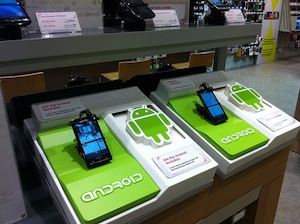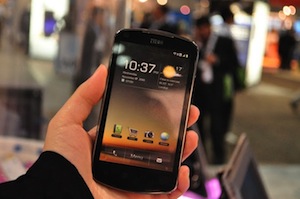There comes a time in someone’s life when he (or she) needs to grow up and upgrade to a new and better phone. Yes, that nice, sturdy block that is your current Android phone performs quite remarkably well but it seems… lacking. The small(ish) screen, the scratched up screen and the not-so-stellar battery life just doesn’t cut it anymore. You want something better, faster, smarter.
With every manufacturer and his mother making Google-powered phones these days, you certainly won’t be lacking in Android options. The problem is choosing the phone that will fit your needs. Here are a few pointers to keep in mind while you’re out deciding which phone you should get:

1. The newest isn’t always the best.
Getting a new phone might gain you the oohs and ahhs of the people around you, but sometimes waiting around a bit helps you snag a better deal. I myself tend to wait a few months before getting the latest and greatest to see if it lives up to the hype. You can also look at older but higher-spec’d models of yesteryear for you fix. These often carry outstanding features your current phone lacks without the faint-inducing price tag.
2. Check if the phone build works for you.
The build quality of a phone is a clincher when it comes to getting an Android upgrade. Go out to your local phone retailer and toy with one of their actual units. See if the grip works for you, if the texture is to your liking and if the buttons are tap-friendly for you. Check not only how it feels on your hand but also in your pocket, which is where it might be most of the time. Heavier phones feel solid but will wear you down if you plan on making calls often.
3. Feel the user interface.
A big part of any Android phone is its interface and each manufacturer often has its own built on top of the standard Android UI. Each has its own pros and cons but you might find some features appealing like HTC Sense’s bird’s eye view of the home screens or Samsung TouchWiz’s custom app trays. Test an actual device running that interface, even if it’s an older model, to see for yourself if it’s something you would enjoy using everyday.
4. The battery should last at least a day with normal use.
Its battery should last at least the entire day with your usual call and text routine coupled with light browsing, some game playing and video watching. At the end of the day, it should have a bit of juice left since draining the battery often isn’t good for its health. A good rule is to go for a model with at least a 1400mAh battery.

5. Get one with a comfortable screen size.
Since this is a touchscreen phone, a bigger screen not only means you can see more stuff, it also means that the onscreen keyboard is more comfortable to use. On the other hand, a bigger screen also consumes more power, so keep that in mind as well. Unless you have slim fingers, get an Android phone that sports at least a 3.5″ screen and it should also sport at least 16M colors. Other specs seem to be of little import aside from tiny quality differences so don’t worry too much if it’s AMOLED, Super LCD, TFT or what not. Gorilla glass ones are a plus though, and it is a life saver in situations when phone meets pavement.
6. Megapixels aren’t the only measure of a good camera.
Spec-pushing retailers always tout the number of pixels a phone’s camera grabs but the fact is, it’s the actual photos that will make or break it. Try doing test shots in low light to see if it does well or browse Flickr for uploaded photos from that phone to gauge the quality. And if you’ve already been spoiled on HD-quality photos, better get a phone that supports that already.
7. Don’t Android beyond your means.
Even for phones that come free with a (expensive) two-year plan, always get a phone that’s in your budget. If you can’t afford it, it might not be for you. Just wait it out a few months or so and you’ll probably be able to get it for cheap.
8. Get the one with the latest Android version.
Manufacturers often aren’t very speedy when it comes to upgrading their current phone lineup to major versions of the Android OS. It’s best to hedge your bets and get a phone that’s already running the latest, most especially if you aren’t the ROM-installing type.
9. Consider a phone maker that updates regularly.
HTC is the king in this regard, with almost all of their current models getting the upgrade treatment a few months after a major version release. It’s certainly not a top priority if you change phones regularly but a nice bonus since you can have an almost-new phone for free with every update.

10. Ignore new fangled specs.
Minor specification stuffers like kickstands, HDMI ports and docks shouldn’t influence your decision when buying a phone. Believe me, it might look nice on paper but once you get it, you will be scratching your head and asking yourself why you paid premium for that doohickey you never use.
11. Don’t get one with a keyboard.
Built-in keyboards used to be great until touchscreens became the norm. Now, it only adds bulk and makes a phone cumbersome to use and besides, Android is all about the touch. So wean yourself away from the BlackBerry buttons and just buy a small external keyboard if you really need one.
12. Get a GSM model if you travel a lot.
Basically, Verizon and Sprint phones (as well as a few more CDMA carriers in other parts of the globe) are the ones you need to avoid like the cooties if you hop often from one country to the next. Their phones don’t use SIM cards unlike the rest of the world and don’t go overseas well. So unless you’re that rare, steel-willed person that can stand a couple of weeks without her Android phone, best to go with GSM (and UMTS) supported phones.
13. If you really (really) love apps, get a phone with at least 500mb.
Yes, you can move these to SD but some of these apps that show widgets or are always on perform better when stored on the phone. It’s not a solid requirement but something to look into when breaking ties.
14. Faster processor isn’t necessarily better.
Unlike with computers, the UI is the one that dictates how well you will interact with the device. Heftier chips won’t mean a thing if the interface is buggy. A fast processor is attractive to a subset of Android fans though: videographers who like to shoot in HD and Android gamers.

15. Is it root-friendly?
For the more intrepid user who likes overclocking PCs and using homebrew software, a rootable phone strikes gold. While it might not be at the top of the list for many, being able to tinker with a phone and extracting its full potential always earns plus points. Here is a non-exhaustive list of root-friendly phones. You can also check out the Cyanogen and XDA forums to see which phones get the most support from the hacking community.
16. Go out and test it yourself.
I’m not talking about those non-functional displays you see: you need to actually use a working unit itself. If your local retailer or carrier allows you to try and bring home the phone for a few days, by all means take advantage of that.
17. Check actual user reviews.
One of the great things about the internet is the easy access to reviews on any device imaginable. Get actual reviews from people who went out, bought the device themselves and wrote about how it handled on the day to day. While preferences might vary, if a reviewer’s experience mimics your own and he gives it high marks, chances are it will also be the same for you.

Conclusion
The most important things to look for when you want to upgrade your Android phone are the user interface and screen size, build quality and battery life. If those three are taken care of, you can then check your secondary preferences like rootability, carrier and so on. And as always, never be fooled by marketing hype, colorful ads and a long spec list.
Related posts:
- QWERTY Dream Phone – the Dual Core Motorola Droid 3 / Solana Specs Revealed!
- Rooting for Dummies: A Beginner’s Guide to Rooting your Android Device
- The Best Android Phone in 2011


Nenhum comentário:
Postar um comentário